cacturne
Attributes
- Species: Cacturne
- Base Experience: 166
- Height: 13
- Weight: 774
- Is Default: True
- Order: 444
- Base Happiness: 35
- Capture Rate: 60
- Color: Green
- Egg Groups: Plant , Humanshape
- Gender Rate: 4
- Has Gender Differences
- Hatch Counter: 20
- Habitat: Rough-Terrain
- Is Baby: False
- Is Legendary: False
- Is Mythical: False
- Shape: Humanoid
Stats
-
HP
-
Attack
-
Defense
-
Special Attack
-
Special Defense
-
Speed
Summary
Cacturne is a dual-type Grass/Dark Pokémon introduced in Generation III.
Type: Grass/Dark
Abilities:
- Sand Veil: Raises the Pokémon's evasion during a sandstorm.
- Water Absorb (Hidden Ability): Restores HP if hit by a Water-type move.
Physical Characteristics:
- Cacturne resembles a humanoid cactus with a green, spiny body.
- It has a large, conical hat-like appendage on its head, resembling a scarecrow's hat, with dark, triangular eyes beneath.
- Its arms are long and thin, ending in spiky hands.
- The entire body is dotted with small, thorny spikes.
Behavior and Habitat:
- Cacturne is primarily found in deserts and arid regions.
- This Pokémon is known to follow travelers in the desert until the travelers can no longer move.
- Its behavior is reminiscent of a nocturnal predator, hunting at night when the desert is cooler.
- It can survive in harsh conditions without water for extended periods.
In Battle:
- Cacturne is a versatile attacker with strong offensive capabilities in both physical and special attacks.
- Notable moves include Needle Arm, Sucker Punch, and Dark Pulse.
- It is effective against Psychic and Ghost types due to its Dark-type moves.
- However, it is vulnerable to Fighting, Flying, Bug, Fire, Ice, and Fairy types.
Evolution:
- Cacturne evolves from Cacnea starting at level 32.
Interesting Facts:
- Cacturne's design and behavior are inspired by scarecrows and cacti, fitting its Grass/Dark typing.
- It is known for its endurance in the harsh desert, symbolizing a relentless pursuer.
- In the Pokémon world, its ability to stalk prey in the desert is both feared and respected.
Pokémon Sprites
Evolution Chain
Moves
Level Up
- Level 1: Poison Sting
- Level 1: Leer
- Level 1: Absorb
- Level 1: Growth
- Level 1: Revenge
- Level 13: Leech Seed
- Level 17: Sand Attack
- Level 19: Assurance
- Level 19: Power Trip
- Level 21: Pin Missile
- Level 25: Ingrain
- Level 29: Feint Attack
- Level 32: Spiky Shield
- Level 35: Spikes
- Level 41: Needle Arm
- Level 41: Sucker Punch
- Level 47: Cotton Spore
- Level 47: Payback
- Level 53: Sandstorm
- Level 59: Destiny Bond
TM/HM
- Cut
- Take Down
- Hyper Beam
- Strength
- Solar Beam
- Dig
- Toxic
- Double Team
- Swift
- Flash
- Rest
- Thief
- Curse
- Protect
- Scary Face
- Giga Drain
- Attract
- Return
- Frustration
- Encore
- Hidden Power
- Rain Dance
- Sunny Day
- Shadow Ball
- Facade
- Focus Punch
- Nature Power
- Taunt
- Helping Hand
- Brick Break
- Knock Off
- Endeavor
- Secret Power
- Bullet Seed
- Magical Leaf
- Natural Gift
- Embargo
- Fling
- Toxic Spikes
- Poison Jab
- Dark Pulse
- Drain Punch
- Focus Blast
- Energy Ball
- Giga Impact
- Nasty Plot
- Zen Headbutt
- Leaf Storm
- Captivate
- Grass Knot
- Venoshock
- Round
- Retaliate
- Bulldoze
- Grassy Terrain
- Confide
- Power Up Punch
- Throat Chop
- Lunge
- Grassy Glide
- Skitter Smack
- Lash Out
- Tera Blast
- Trailblaze
Breeding
Tutor
Other
Flavor Text Entries
- Ruby: During the daytime, CACTURNE remains unmoving so that it does not lose any moisture to the harsh desert sun. This Pokémon becomes active at night when the temperature drops.
- Sapphire: If a traveler is going through a desert in the thick of night, CACTURNE will follow in a ragtag group. The Pokémon are biding their time, waiting for the traveler to tire and become incapable of moving.
- Emerald: After spending thousands of years in harsh deserts, its blood transformed into the same substances as sand. It is nocturnal, so it hunts at night.
- Firered: It lives in deserts. It becomes active at night when it hunts for prey exhausted from the desert’s heat.
- Leafgreen: It lives in deserts. It becomes active at night when it hunts for prey exhausted from the desert’s heat.
- Diamond: It becomes active at night, seeking prey that is exhausted from the day’s desert heat.
- Pearl: It becomes active at night, seeking prey that is exhausted from the day’s desert heat.
- Platinum: It becomes active at night, seeking prey that is exhausted from the day’s desert heat.
- Heartgold: Packs of them follow travelers through the desert until the travelers can no longer move.
- Soulsilver: Packs of them follow travelers through the desert until the travelers can no longer move.
- Black: It becomes active at night, seeking prey that is exhausted from the day’s desert heat.
- White: It becomes active at night, seeking prey that is exhausted from the day’s desert heat.
- Black-2: It becomes active at night, seeking prey that is exhausted from the day’s desert heat.
- White-2: It becomes active at night, seeking prey that is exhausted from the day’s desert heat.
- X: It becomes active at night, seeking prey that is exhausted from the day’s desert heat.
- Y: Packs of them follow travelers through the desert until the travelers can no longer move.
- Omega-Ruby: During the daytime, Cacturne remains unmoving so that it does not lose any moisture to the harsh desert sun. This Pokémon becomes active at night when the temperature drops.
- Alpha-Sapphire: If a traveler is going through a desert in the thick of night, Cacturne will follow in a ragtag group. The Pokémon are biding their time, waiting for the traveler to tire and become incapable of moving.
Cards
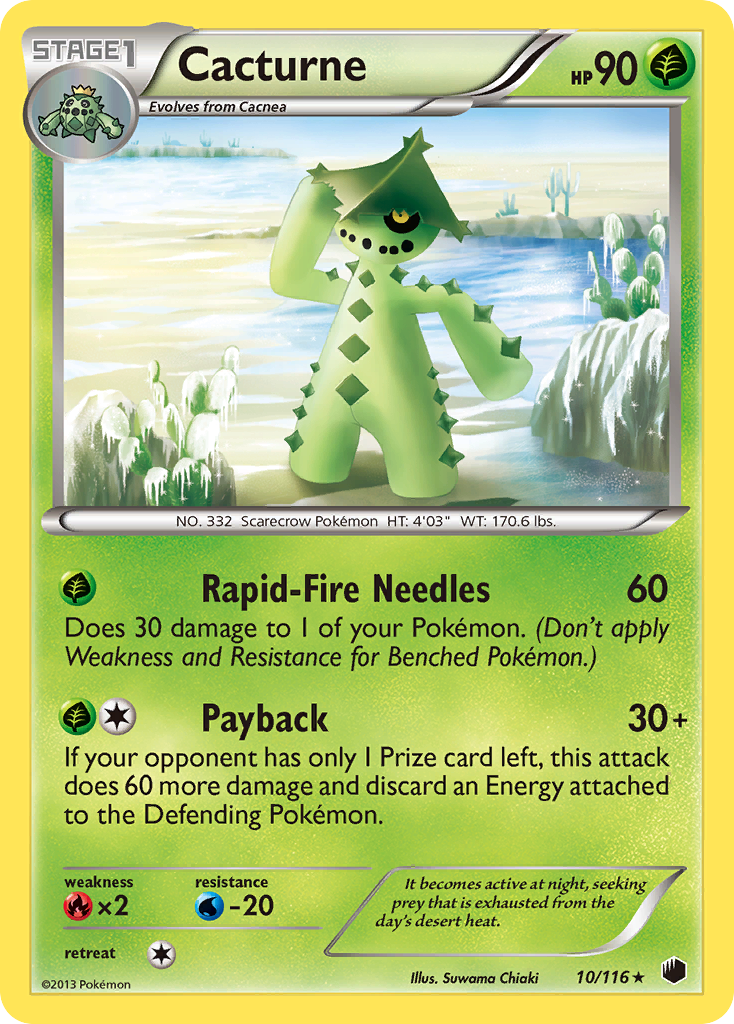
Created by Suwama Chiaki for the Unknown Set set.
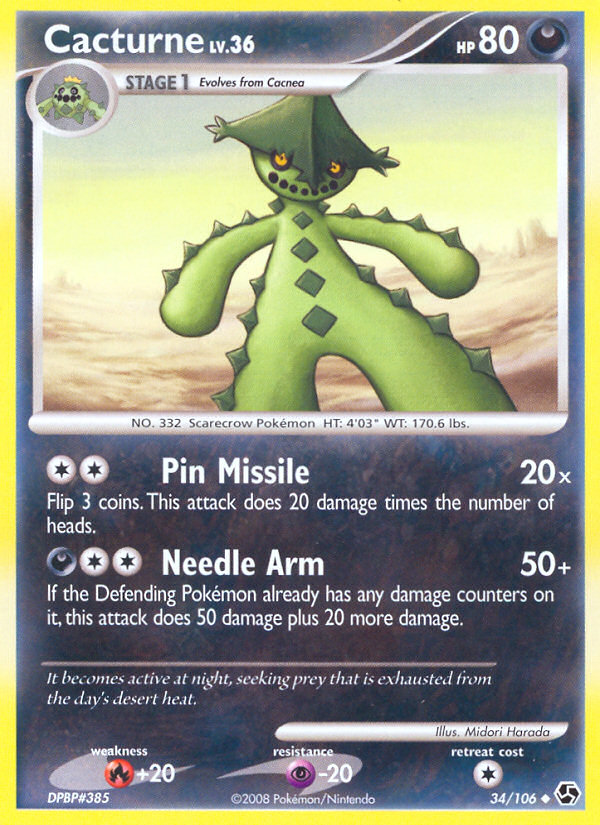
Created by Midori Harada for the Unknown Set set.
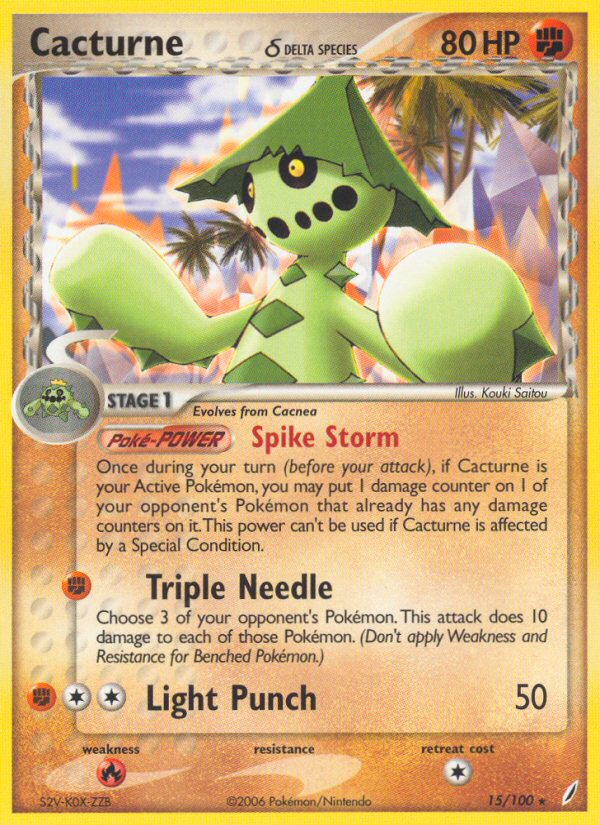
Created by Kouki Saitou for the Unknown Set set.
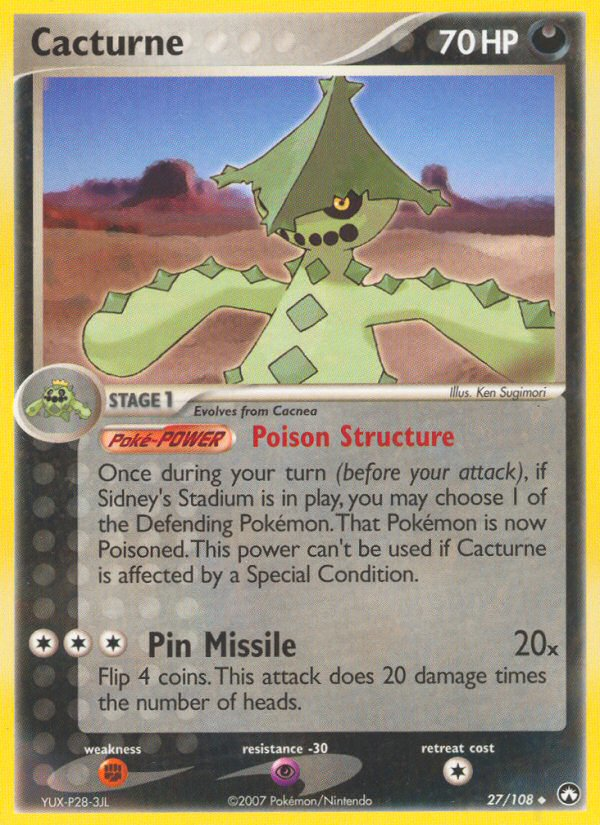
Created by Ken Sugimori for the Unknown Set set.

Created by Atsuko Nishida for the Unknown Set set.
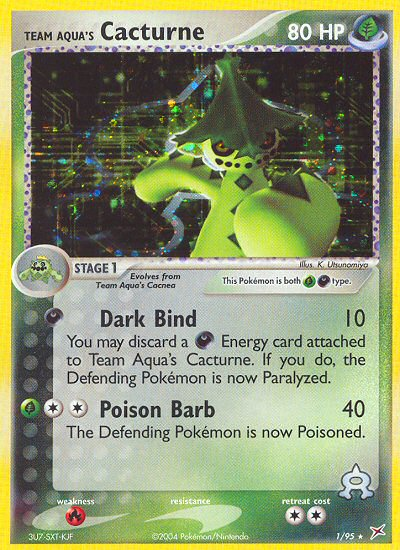
Created by K. Utsunomiya for the Unknown Set set.
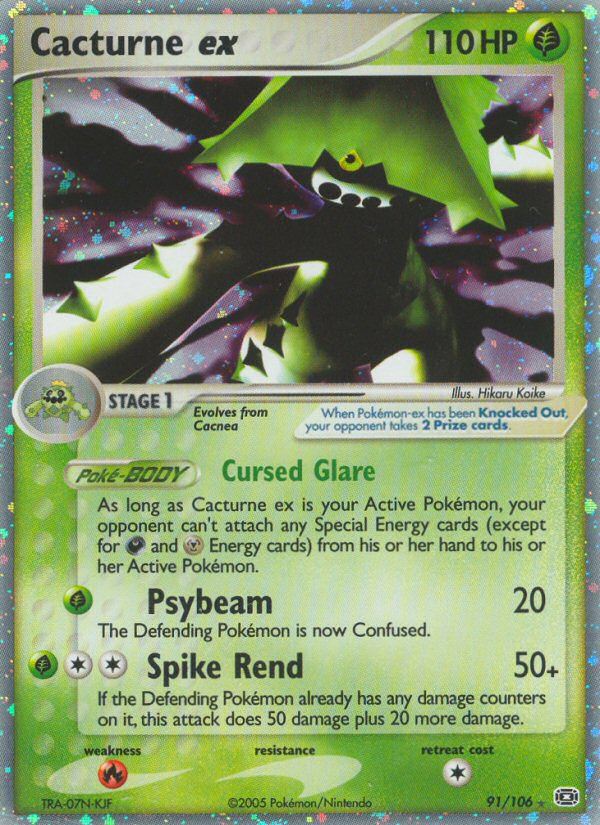
Created by Hikaru Koike for the Unknown Set set.

Created by Mitsuhiro Arita for the Unknown Set set.

Created by Mina Nakai for the Unknown Set set.
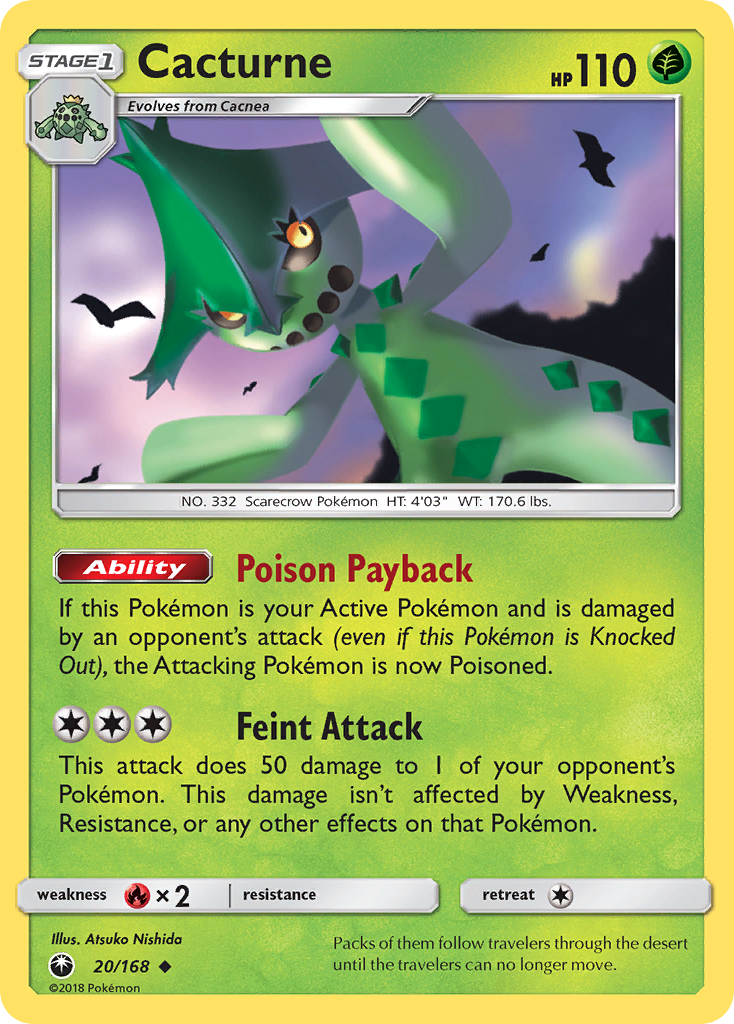
Created by Atsuko Nishida for the Unknown Set set.
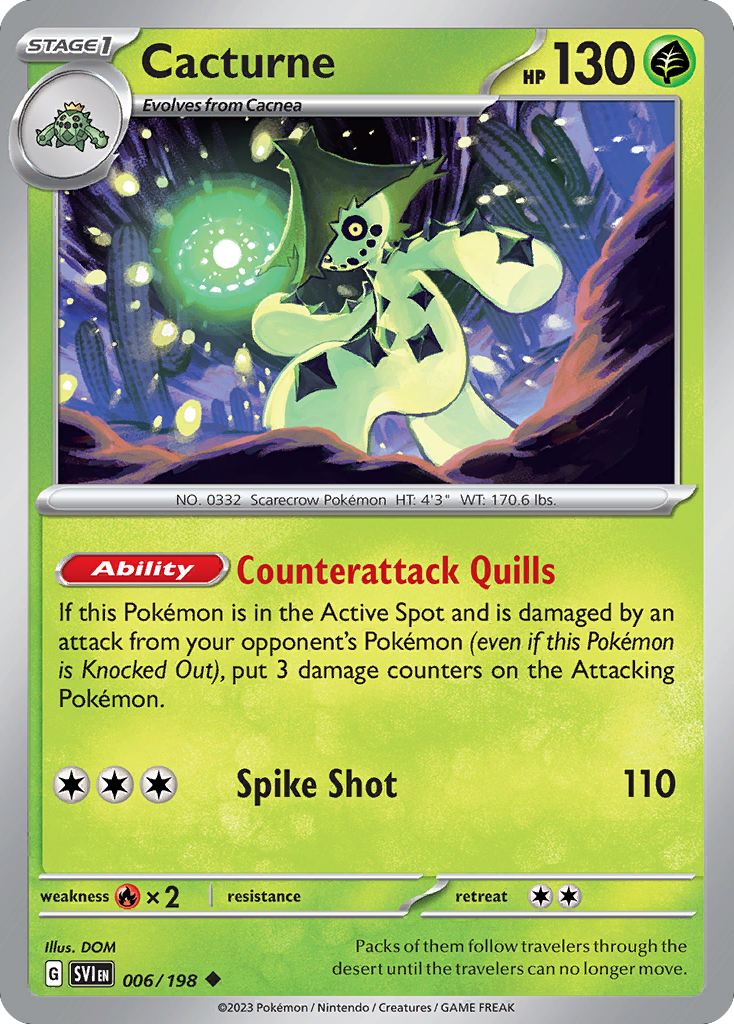
Created by Dom for the Unknown Set set.
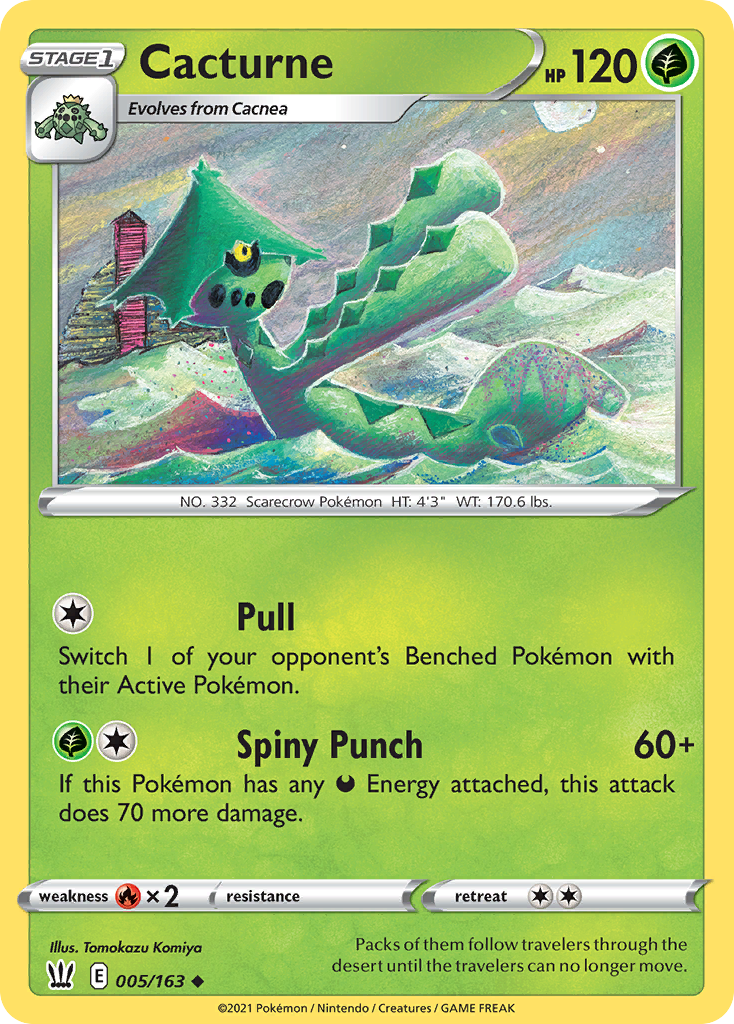
Created by Tomokazu Komiya for the Unknown Set set.
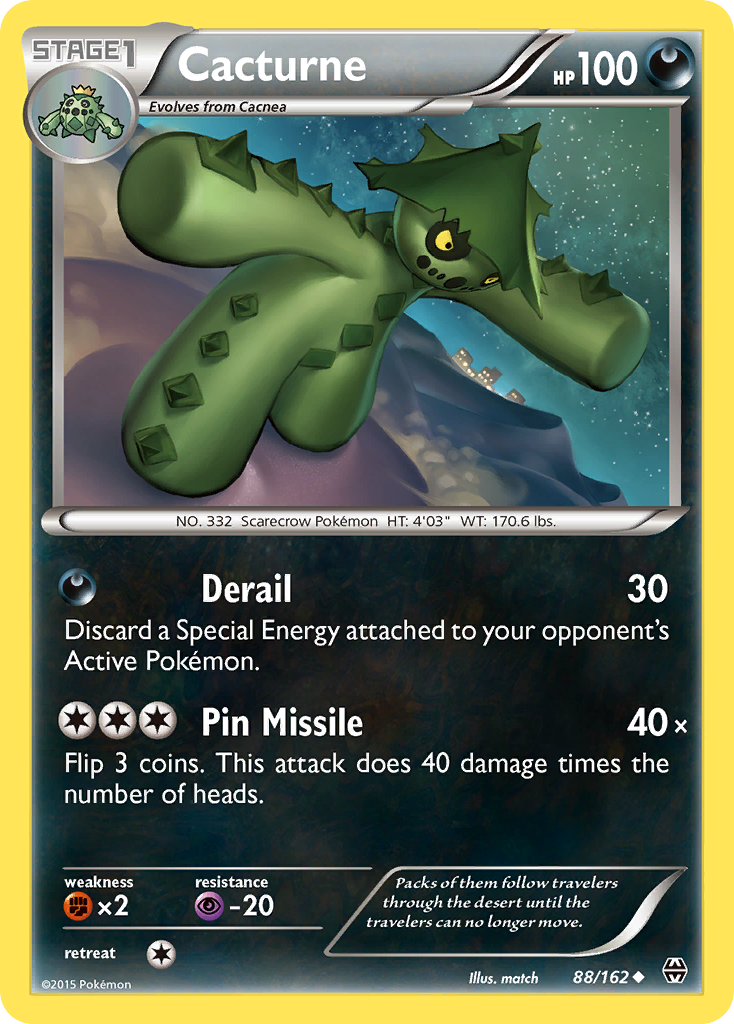
Created by Match for the Unknown Set set.